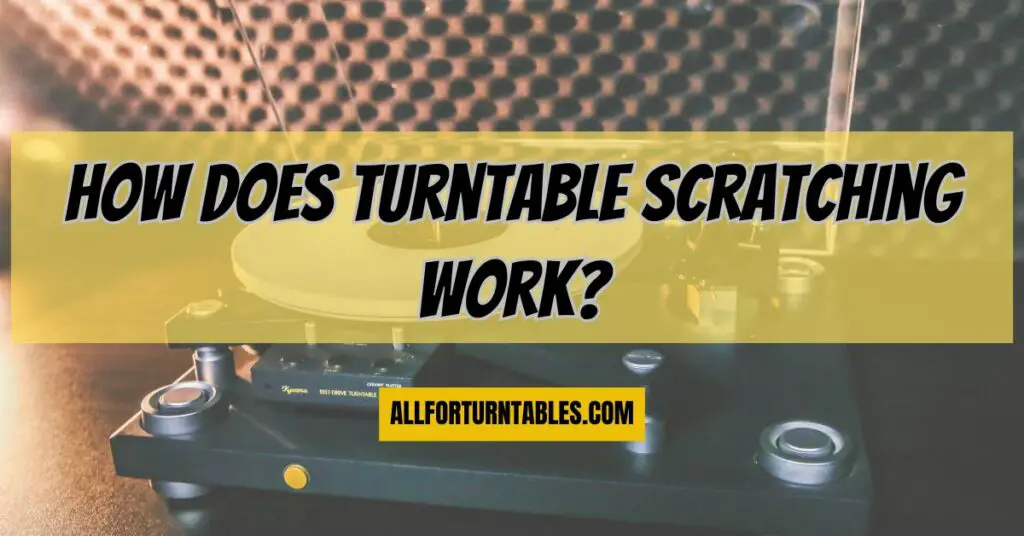Turntable scratching, a mesmerizing art form that transforms vinyl records into musical instruments, has been a cornerstone of hip-hop and electronic music culture for decades. If you’ve ever wondered how those skilled DJs create those distinctive, rhythmic, and dynamic sounds by manipulating a spinning record, you’re in the right place. In this comprehensive article, we’ll demystify the magic behind turntable scratching and provide you with a clear understanding of how it works. Whether you’re an aspiring DJ or simply a curious music enthusiast, you’ll gain insights into the techniques and principles that fuel this captivating skill.
The Basics of Turntable Scratching
Before we dive into the mechanics of turntable scratching, let’s establish a few fundamental concepts:
- Turntable Components:
- Platter: This is the rotating platform where the vinyl record sits.
- Tonearm: The arm that holds the stylus (needle) and can be moved across the record.
- Stylus: The needle that reads the grooves of the record and produces sound.
- Vinyl Record: The source of the music, with grooves that store audio information.
- Mixer: The DJ’s control center for adjusting audio signals and blending tracks.
- Scratching Tools:
- Slipmat: A low-friction mat placed between the platter and the record to facilitate manual manipulation.
- DJ Needles/Cartridges: Specialized needles and cartridges designed for scratching, providing accurate tracking and durability.
How Turntable Scratching Works
Now, let’s explore the mechanics of turntable scratching:
- Manipulating the Record:
Turntable scratching involves moving the vinyl record back and forth under the stylus (needle) while it’s playing. This motion is what produces the signature “scratching” sound. DJs use their fingers to gently touch and manipulate the record, causing it to change speed and direction.
- Forward and Reverse Scratching:
DJs can scratch in both forward and reverse directions. Forward scratching involves moving the record in the direction it naturally spins, while reverse scratching is the opposite. This manipulation allows for a wide range of sounds and rhythms.
- Cue Points:
DJs often use cue points, marked spots on the vinyl, to control where the scratching begins and ends. This precision is crucial for creating rhythmic and musical patterns.
- Crossfader and Mixer:
The crossfader on a DJ mixer allows the DJ to control the volume and blend between two audio sources, typically two turntables. By rapidly moving the crossfader back and forth, the DJ can create the distinctive “cutting” effect in the music.
- Beat Matching:
Beat matching is the art of aligning the beats of two songs, enabling seamless transitions and creating a continuous mix. DJs use pitch control to adjust the turntable’s speed and match the beats.
- Effects and Techniques:
Scratching is not limited to moving the record back and forth. DJs employ various techniques such as chirping, flares, and transforms to create a diverse range of sounds. These techniques involve precise hand movements and timing.
The Science Behind Turntable Scratching
At its core, turntable scratching works by momentarily altering the speed and direction of the record to create variations in pitch and timbre. Here’s a simplified breakdown of the science:
- When a DJ manipulates the record by slowing it down, it lowers the pitch of the sound. Conversely, speeding up the record raises the pitch.
- The stylus reads the grooves on the record, and any changes in speed and direction are instantly translated into changes in the audio output.
- Rapid back-and-forth motion creates the distinctive “scratching” sound, which is essentially the stylus jumping back and forth in the grooves.
- Precise timing and control are essential for creating rhythmic patterns and effects.
Turntable scratching is a fusion of creativity and technical skill. DJs use their hands, ears, and a deep understanding of music to manipulate vinyl records in ways that transcend the traditional use of the turntable. It’s a dynamic and captivating art form that has left an indelible mark on the music world.
Whether you’re a budding DJ looking to master the craft or an enthusiast seeking to appreciate the art on a deeper level, understanding how turntable scratching works provides a deeper connection to the magic of this musical phenomenon. The next time you witness a DJ scratching, you’ll have a newfound appreciation for the skill, creativity, and science behind the sound.

